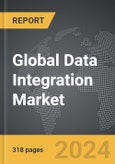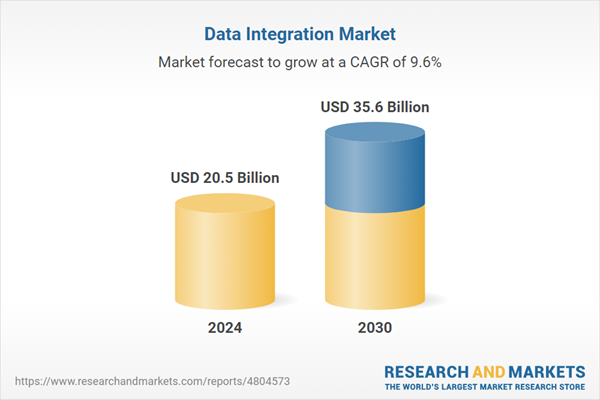The global market for Data Integration was valued at US$20.5 Billion in 2024 and is projected to reach US$35.6 Billion by 2030, growing at a CAGR of 9.6% from 2024 to 2030. This comprehensive report provides an in-depth analysis of market trends, drivers, and forecasts, helping you make informed business decisions. The report includes the most recent global tariff developments and how they impact the Data Integration market.
Segments: Component (Tools, Services); Deployment (On-Premise Deployment, Cloud).
Geographic Regions/Countries: World; United States; Canada; Japan; China; Europe (France; Germany; Italy; United Kingdom; and Rest of Europe); Asia-Pacific; Rest of World.
The analysts continuously track trade developments worldwide, drawing insights from leading global economists and over 200 industry and policy institutions, including think tanks, trade organizations, and national economic advisory bodies. This intelligence is integrated into forecasting models to provide timely, data-driven analysis of emerging risks and opportunities.
Global Data Integration Market - Key Trends and Drivers Summarized
What Is Data Integration and Why Is It Critical for Modern Enterprises?
Data integration involves combining data from different sources to provide a unified view, making it essential for businesses that manage various data streams. In today's digital age, enterprises accumulate data from multiple origins - social media, enterprise applications, mobile apps, and IoT devices, among others. Integrating this data provides a holistic view of business operations, enabling more informed decision-making and strategic planning. Effective data integration helps organizations to break down information silos, improve data quality, and ensure consistency across different business functions. This unified data approach enhances operational efficiency by enabling analytics tools to work with comprehensive datasets, thus generating more accurate insights that drive business growth and innovation.How Does Data Integration Facilitate Advanced Data Analytics and Decision Making?
By harmonizing disparate data into a cohesive dataset, data integration lays the foundation for advanced analytics and business intelligence. This process allows analysts to draw comprehensive insights that would be impossible to deduce from isolated data chunks. For instance, integrating customer data from CRM systems, sales figures from ERP systems, and customer feedback from social media platforms allows businesses to create a 360-degree view of customer interactions and satisfaction. Such integrated data architectures enable predictive analytics, which can forecast trends and behaviors, thereby informing future strategies. Furthermore, data integration supports real-time analytics, providing businesses with the ability to make decisions quickly in response to market changes or operational issues, thus enhancing agility and competitive advantage.What Are the Key Challenges in Data Integration?
Implementing an effective data integration strategy is fraught with challenges, primarily due to the diversity of data formats, the volume of data, and compatibility between old and new systems. One major hurdle is the technical complexity involved in integrating legacy systems with newer cloud-based platforms. These systems often use different data standards and structures, making seamless integration a complex and resource-intensive task. Additionally, data quality poses a significant challenge; inconsistent data can lead to poor analytics and misguided business decisions. Ensuring data security during the integration process is also crucial, as data breaches can lead to significant financial losses and damage to reputation. Overcoming these challenges requires robust data governance practices, sophisticated integration tools, and often a cultural shift within the organization towards data-driven decision-making.What Drives the Growth in the Data Integration Market?
The growth in the data integration market is driven by several factors, beginning with the exponential increase in data generation across all sectors of the economy. As businesses become more data-centric, the demand for solutions that can consolidate data from diverse sources into actionable insights is rapidly increasing. The shift towards cloud computing and the adoption of SaaS applications further fuel the need for advanced data integration tools that can operate across distributed computing environments. Additionally, the rise of big data and analytics has compelled companies to invest in robust data integration frameworks to leverage the vast amounts of unstructured data they collect. Economic factors such as the need to improve operational efficiency and reduce IT expenditures also contribute to the adoption of integration technologies. Moreover, regulatory compliance requirements across various industries necessitate the integration of data to ensure accuracy and transparency in reporting. These technological, economic, and regulatory drivers collectively ensure a vibrant and expanding market for data integration solutions, underscoring their essential role in modern digital strategies.Report Scope
The report analyzes the Data Integration market, presented in terms of units. The analysis covers the key segments and geographic regions outlined below.Segments: Component (Tools, Services); Deployment (On-Premise Deployment, Cloud).
Geographic Regions/Countries: World; United States; Canada; Japan; China; Europe (France; Germany; Italy; United Kingdom; and Rest of Europe); Asia-Pacific; Rest of World.
Key Insights:
- Market Growth: Understand the significant growth trajectory of the Data Integration Tools segment, which is expected to reach US$20.8 Billion by 2030 with a CAGR of a 8.9%. The Data Integration Services segment is also set to grow at 10.7% CAGR over the analysis period.
- Regional Analysis: Gain insights into the U.S. market, valued at $5.8 Billion in 2024, and China, forecasted to grow at an impressive 9.0% CAGR to reach $5.4 Billion by 2030. Discover growth trends in other key regions, including Japan, Canada, Germany, and the Asia-Pacific.
Why You Should Buy This Report:
- Detailed Market Analysis: Access a thorough analysis of the Global Data Integration Market, covering all major geographic regions and market segments.
- Competitive Insights: Get an overview of the competitive landscape, including the market presence of major players across different geographies.
- Future Trends and Drivers: Understand the key trends and drivers shaping the future of the Global Data Integration Market.
- Actionable Insights: Benefit from actionable insights that can help you identify new revenue opportunities and make strategic business decisions.
Key Questions Answered:
- How is the Global Data Integration Market expected to evolve by 2030?
- What are the main drivers and restraints affecting the market?
- Which market segments will grow the most over the forecast period?
- How will market shares for different regions and segments change by 2030?
- Who are the leading players in the market, and what are their prospects?
Report Features:
- Comprehensive Market Data: Independent analysis of annual sales and market forecasts in US$ Million from 2024 to 2030.
- In-Depth Regional Analysis: Detailed insights into key markets, including the U.S., China, Japan, Canada, Europe, Asia-Pacific, Latin America, Middle East, and Africa.
- Company Profiles: Coverage of players such as Actian Corporation, Attunity Ltd., Cisco Systems, Inc., Denodo Technologies, HVR Software, Inc. and more.
- Complimentary Updates: Receive free report updates for one year to keep you informed of the latest market developments.
Some of the 289 companies featured in this Data Integration market report include:
- Actian Corporation
- Attunity Ltd.
- Cisco Systems, Inc.
- Denodo Technologies
- HVR Software, Inc.
- IBM Corporation
- Informatica LLC
- Information Builders, Inc.
- Microsoft Corporation
- Oracle Corporation
- Pitney Bowes, Inc.
- SAP SE
- SAS Institute, Inc.
- Syncsort
- Talend SA
Tariff Impact Analysis: Key Insights for 2025
Global tariff negotiations across 180+ countries are reshaping supply chains, costs, and competitiveness. This report reflects the latest developments as of April 2025 and incorporates forward-looking insights into the market outlook.The analysts continuously track trade developments worldwide, drawing insights from leading global economists and over 200 industry and policy institutions, including think tanks, trade organizations, and national economic advisory bodies. This intelligence is integrated into forecasting models to provide timely, data-driven analysis of emerging risks and opportunities.
What’s Included in This Edition:
- Tariff-adjusted market forecasts by region and segment
- Analysis of cost and supply chain implications by sourcing and trade exposure
- Strategic insights into geographic shifts
Buyers receive a free July 2025 update with:
- Finalized tariff impacts and new trade agreement effects
- Updated projections reflecting global sourcing and cost shifts
- Expanded country-specific coverage across the industry
Table of Contents
I. METHODOLOGYII. EXECUTIVE SUMMARY2. FOCUS ON SELECT PLAYERSIII. MARKET ANALYSISIV. COMPETITION
1. MARKET OVERVIEW
3. MARKET TRENDS & DRIVERS
4. GLOBAL MARKET PERSPECTIVE
UNITED STATES
CANADA
JAPAN
CHINA
EUROPE
FRANCE
GERMANY
ITALY
UNITED KINGDOM
REST OF EUROPE
ASIA-PACIFIC
REST OF WORLD
Companies Mentioned (Partial List)
A selection of companies mentioned in this report includes, but is not limited to:
- Actian Corporation
- Attunity Ltd.
- Cisco Systems, Inc.
- Denodo Technologies
- HVR Software, Inc.
- IBM Corporation
- Informatica LLC
- Information Builders, Inc.
- Microsoft Corporation
- Oracle Corporation
- Pitney Bowes, Inc.
- SAP SE
- SAS Institute, Inc.
- Syncsort
- Talend SA
Table Information
| Report Attribute | Details |
|---|---|
| No. of Pages | 318 |
| Published | April 2025 |
| Forecast Period | 2024 - 2030 |
| Estimated Market Value ( USD | $ 20.5 Billion |
| Forecasted Market Value ( USD | $ 35.6 Billion |
| Compound Annual Growth Rate | 9.6% |
| Regions Covered | Global |









